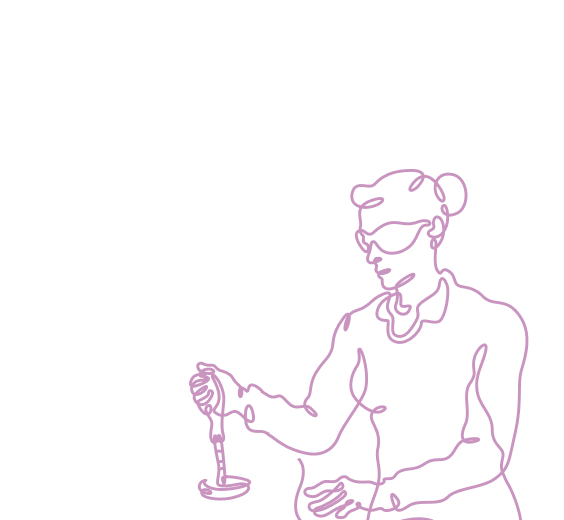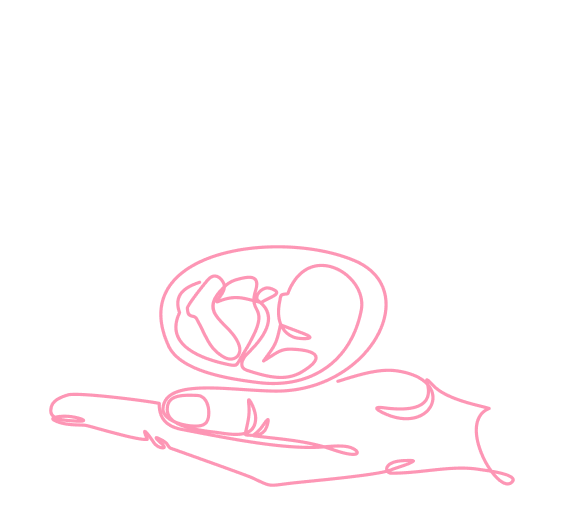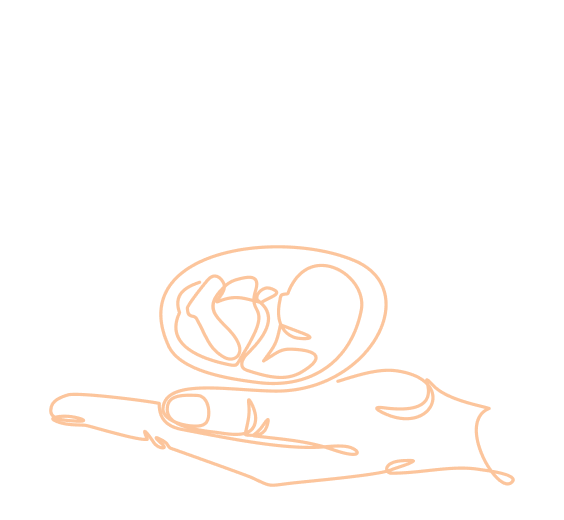As the names suggest, fresh cycles use eggs that have been recently retrieved for fertilisation, while frozen/thaw cycles use frozen embryos that will need to thaw before being implanted.8,9
Below is a diagram showing how a potential complete cycle of ART, which includes one fresh cycle and two frozen/thaw cycles, could lead to a potential pregnancy.9
By freezing embryos, future IVF cycles are simpler, less expensive and less invasive than the initial cycle since ovarian stimulation and egg retrieval are not required. However, if all fresh and frozen attempts are not successful, then the process would start again at step 1.9
Click on the links below to learn more about each step.9
Fresh Cycle
1Ovarian stimulation

2Egg retrieval

3Fertilisation – 2 options
They will aim to fertilise the collected eggs in one of two ways:
AIn vitro fertilisation (IVF)

BIntracytoplasmic sperm injection (ICSI) process

4Embryo development

5Embryo transfer

6Taking a
pregnancy test

Frozen Cycle

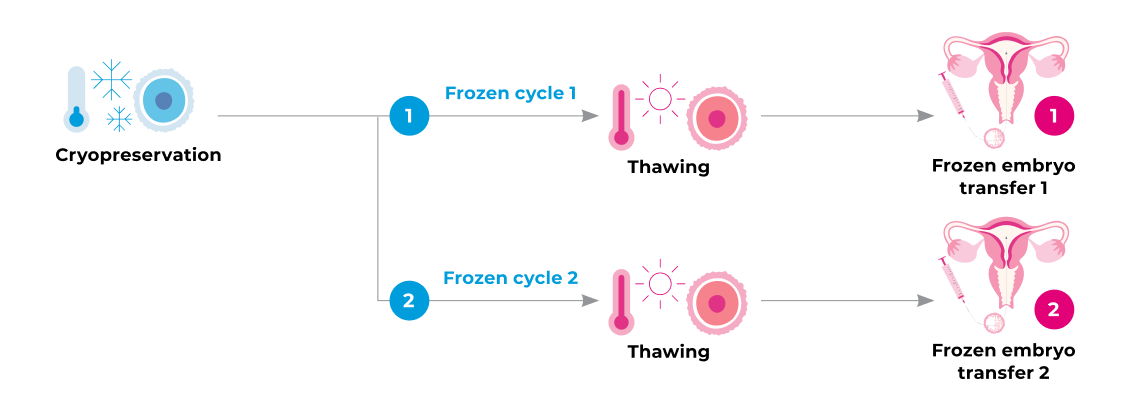
Frozen cycle
There may be more than one embryo that could be used for an embryo transfer, in which case your fertility specialist may suggest freezing the ones that won’t be used during the fresh cycle of ART.13
Cryopreservation of embryos has several advantages:
While cryopreservation offers many advantages, it also introduces a few social, ethical and legal concerns to consider. For example:23
Studies are still being conducted to determine whether fresh or frozen embryos are better. It’s best to consult with your fertility specialist to determine which is best for you.
Step 1
Ovarian stimulation
Medications that may be needed during the ART process
It’s important to know that one ART cycle correlates to one full menstrual cycle where treatments and procedures are carefully planned to enhance your body’s natural process.10
There are different brands of medications that can be used during the ovarian stimulation phase, but their aim is the same: stimulate the development of follicles to increase the chances of producing more than one viable egg for egg retrieval.3
Medication protocols are specific to you
When starting ART, your fertility specialist will assign you an appropriate treatment protocol based on diagnostic tests, which will take into consideration how you may respond to ovarian stimulation (ie, low, normal, or high response based on ovarian reserve and age) and/or prior ovarian stimulation response history (if you’ve undergone ART before).11,12 The difference for females that are low responders to ovarian stimulation is that fewer eggs may be retrieved.8
Here are a few things to know:6,13,14
- Stimulation medications will typically be introduced early in your cycle
- Since everyone responds differently to medications, your fertility specialist will be monitoring your progress through ultrasounds and blood tests regularly
- Based on their ongoing monitoring, they will adjust medications as needed
Common medication used for conventional stimulation
When medications may be introduced in a conventional stimulation6,13-16
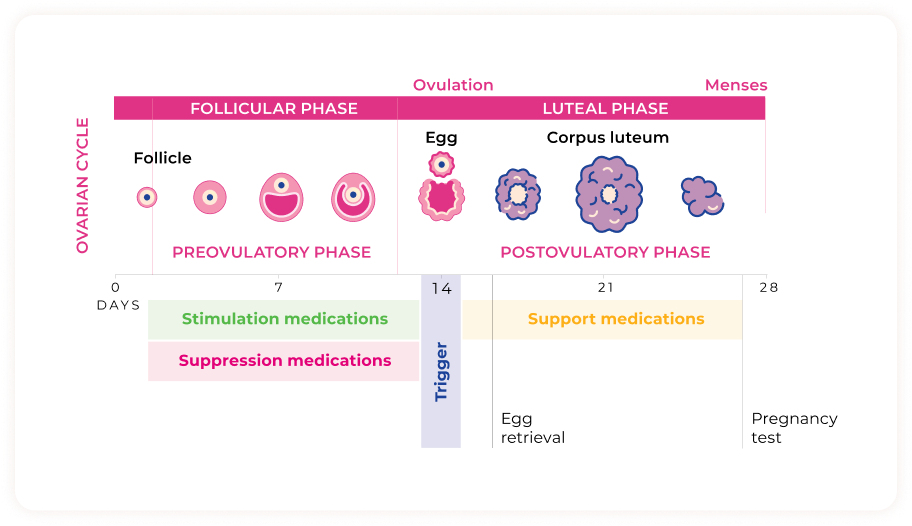
Try not to get too concerned by the type of medication prescribed, it’s more important to know what its role is. You can use the table to gain a better understanding of what the medication you’ve been prescribed is used for.
Common medication used for conventional stimulation
Like all medication, fertility medication can cause side effects
Some potential side effects include:16.17
Mild bruising at injection site
Nausea and vomiting
Hot flashes
Headaches
Mood swings and fatigue
If you experience a side effect that causes you discomfort or any other symptoms which concern you, be sure to speak to your fertility specialist or nurse about it. If you are experiencing any severe discomfort, don’t wait – visit an emergency department immediately.17
Step 2
Egg retrieval
What happens during the egg retrieval stage?
Your follicles will typically be ready for egg retrieval ~8–14 days after you begin your ovarian stimulation cycle,13 at which time you will be instructed by your fertility specialist to take medication in preparation for retrieval.14
Egg retrieval can be done at the clinic 34–36 hours after that final injection and before ovulation occurs.14 The number of eggs retrieved is directly related to the number of ovaries, ability to reach the ovaries, the level of stimulation and the number of follicles that developed in response to stimulation.18
What can I expect from the procedure?
During the procedure, you’ll be sedated or provided a local anaesthetic, and be given pain medication.14
- The usual retrieval method is through transvaginal ultrasound aspiration, where a probe is inserted into the vagina to visualise follicles. Once found, a needle is carefully inserted into follicles to retrieve eggs.
- The eggs are removed through the needle using a suction device. ~20 mins is needed to remove multiple eggs.
- After removal, it’s possible to feel mild discomfort from cramping or feelings of pressure.
- Eggs are then incubated and further examined to see if they are viable. Not all eggs collected will be able to be successfully fertilised.
At this point, eggs can either be:8
- Used in IVF to create embryos for a fresh transfer
- Frozen for future use
Step 3
Egg fertilisation
What happens during the egg fertilisation stage?
Below are two methods that can be used to fertilise eggs
In vitro fertilisation (IVF)
In this method, the collected eggs are placed with prepared sperm for fertilisation.14
Intracytoplasmic sperm injection (ICSI) process
In this method, a single healthy sperm is injected directly into a mature egg. This option may be used when semen quality or number is an issue, or if conventional fertilisation hasn’t worked in the past.14
Step 4
Embryo development
How long does it take for an embryo to develop?
After the sperm fertilises the egg, it takes about 3 days for an embryo, which contains about 6–10 cells, to form. The cells will continue to multiply, and by day 5/6 they become a blastocyst. The blastocyst is made up of two components: the inner group of cells, which is the developing embryo; and the outer group of cells, which form around the embryo to protect and nourish it.13,19
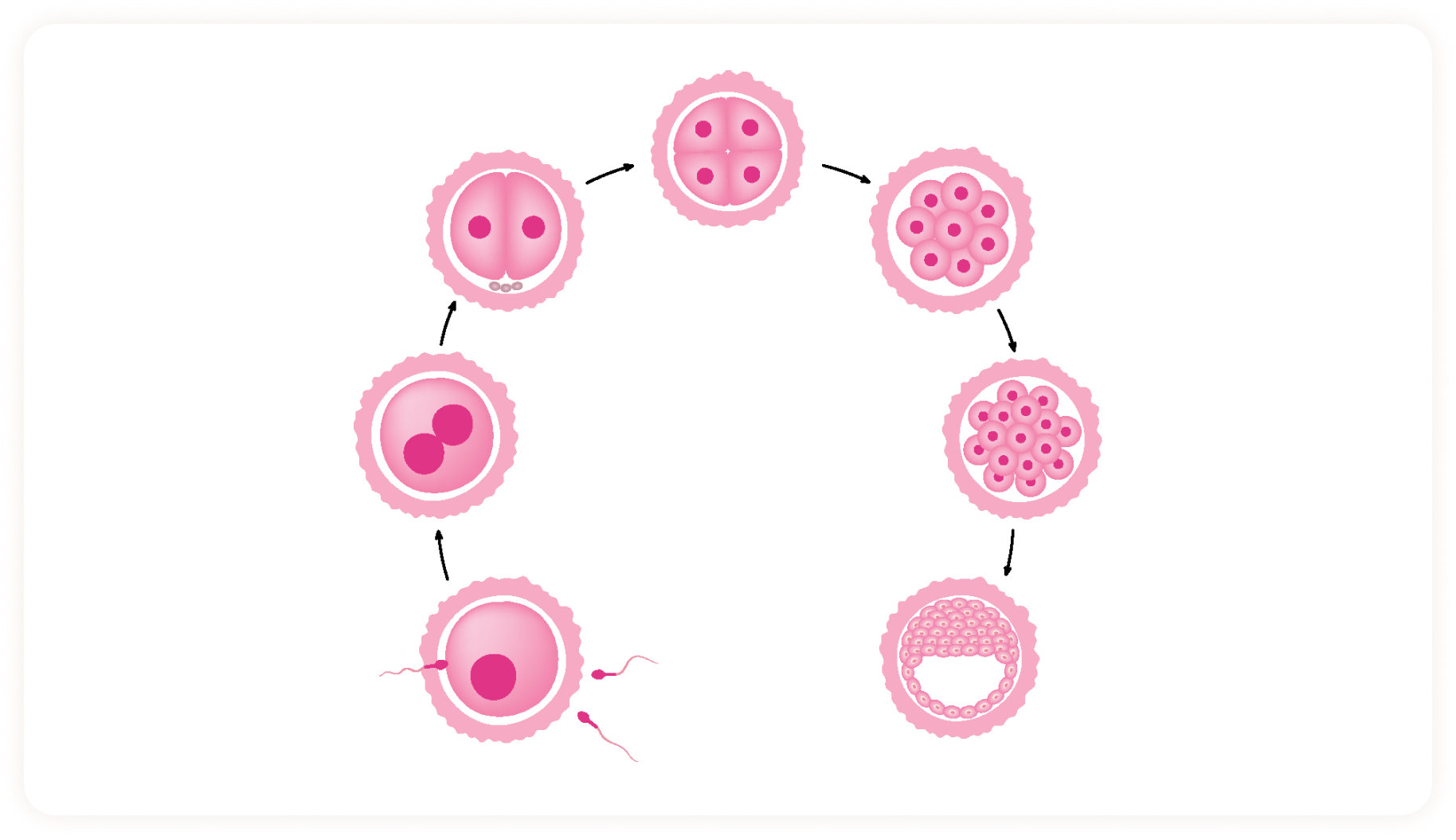
What is pre-implantation genetic testing?
Genetic abnormalities are more common when using sperm or eggs from older individuals. As such, while embryos are developing, a small sample, or biopsy, can be collected from each and used to screen for specific genetic diseases or abnormalities in a process called pre-implantation genetic testing (PGT). PGT consists of a set of different techniques, and the goal is to identify any genetic conditions or chromosomal abnormalities before implanting the embryo.6, 20
Although pre-implementation genetic testing aims to reduce the likelihood of parents passing on genetic problems, it doesn’t eliminate the risk in its entirety.6
Step 5
Embryo transfer
What can I expect from the procedure?
For a fresh cycle embryo transfer, the procedure can be done at the clinic around 2–5 days after egg retrieval. The procedure is usually painless, but a mild sedative can be used. Mild cramping could be experienced during the procedure.14
- A catheter (a long thin tube) is carefully inserted into the vagina, through the cervix, and into the uterus.
- A syringe that contains one or more of the embryos along with a small amount of fluid is attached to the end of the catheter.
- The embryo is then injected through the catheter and into the uterus.
- If successful, the embryo will implant in the lining of the uterus.
It is not guaranteed that the embryo will implant.
After the procedure typical daily activities can be resumed; however, it’s advised to avoid vigorous activity, which may cause some discomfort. Some common side effects that can occur during the procedure include:14
- Passing of a small amount of fluid or blood
- Breast tenderness
- Mild bloating and/or cramping
- Constipation
If you experience a side effect that causes you mild discomfort, be sure to speak to your fertility specialist or nurse about it. If you are experiencing any severe discomfort, don’t wait – visit an emergency department immediately.
For a frozen/thaw cycle embryo transfer, the procedure is similar.9 But remember, in order for the embryo to implant in the lining of the uterus, it needs to be ready. Thickening of the lining of the uterus happens in the luteal phase of the menstrual cycle,15 so your fertility specialist may perform tests to make sure the lining is ready for potential implantation prior to an embryo transfer.21 If it is not, medication may be given to get the lining prepared.14
Step 6
Taking pregnancy test
About 9–12 days after the embryo transfer, a pregnancy test will be performed to see if the IVF cycle was successful. If the pregnancy test result is positive, a second test is typically performed.18
If you’re pregnant, your fertility specialist will continue to monitor you for complications (ie, potential miscarriages, ectopic pregnancies, or multiple pregnancies) until you reach 8–10 weeks of gestation. After that, you will be cleared to go to your obstetrician of choice for the remainder of your pregnancy.18
- Manders M, et al. Cochrane Database Syst Rev 2015; (3): CD011345.
- Zegers-Hochschild F, et al. Hum Reprod 2017; 32(9): 1786–1801.
- Jain M, Singh M. Assisted reproductive technology (ART) techniques. In: StatPearls. Treasure Island: StatPearls Publishing, 2023. Available at: https://www.ncbi.nlm.nih.gov/books/NBK576409. Accessed March 2023.
- Glazer ES. Paths to parenthood: receiving an embryo donation. Harvard Health Publishing, February 2022. Available at: https://www.health.harvard.edu/blog/paths-to-parenthood-receiving-an-embryo-donation-202202032682. Accessed January 2024.
- Cleveland Clinic. Gestational surrogacy. Reviewed July 2022. Available at: https://my.clevelandclinic.org/health/articles/23186-gestational-surrogacy. Accessed January 2024.
- Forman EJ and Lobo RA. In vitro fertilization. In: Valea FA, editor. Comprehensive gynecology, 8th ed. Philadelphia: Elsevier, 2021: pp 861–72.
- Kupka MS, et al. Eur J Obstet Gynecol Reprod Biol 2003; 110(2): 190–5.
- Society for Assisted Reproductive Technology. Fresh and frozen embryo transfers. Available at: https://www.sart.org/patients/fyi-videos/fresh-and-frozen-embryo-transfers. Accessed March 2023.
- Chambers GM, et al. Med J Aust 2017; 207(3): 114–8.
- The Fertility Society of Australia and New Zealand. IVF. Available at: https://www.fertilitysociety.com.au/ivf-treatment-australia-new-zealand. Accessed May 2022.
- ESHRE Reproductive Endocrinology Guideline Group. Ovarian stimulation for IVF/ICSI. October 2019. Available at: https://www.eshre.eu/Guidelines-and-Legal/Guidelines/Ovarian-Stimulation-in-IVF-ICSI. Accessed May 2023.
- Lobo, RA. Infertility, etiology, diagnostic evaluation, management, prognosis. In: Valea FA, editor. Comprehensive gynecology, 8th ed. Philadelphia: Elsevier, 2021: pp 838–60.
- American Society for Reproductive Medicine. Assisted reproductive technologies: a guide for patients. Revised 2015. Available at: http://www.fertilityanswers.com/wp-content/uploads/2016/04/assisted-reproductive-technologies-booklet.pdf. Accessed January 2024.
- Mayo Clinic. In vitro fertilization. Available at: https://www.mayoclinic.org/tests-procedures/in-vitro-fertilization/about/pac-20384716. Accessed April 2022.
- Oyelowo T. Menstrual cycle. In: Mosby’s guide to women’s health. Missouri: Mosby, 2007: pp 11–15.
- Cleveland Clinic. IVF (in vitro fertilization). Reviewed February 2022. Available at: https://my.clevelandclinic.org/health/treatments/22457-ivf. Accessed March 2023.
- National Health Service. IVF: risks. Reviewed October 2021. Available at: https://www.nhs.uk/conditions/ivf/risks. Accessed March 2023.
- Society for Assisted Reproductive Technology. ART: step-by-step guide. Available at: https://www.sart.org/patients/a-patients-guide-to-assisted-reproductive-technology/general-information/art-step-by-step-guide. Accessed March 2023.
- Mayo Clinic. Blastocyst. Available at: https://www.mayoclinic.org/tests-procedures/in-vitro-fertilization/multimedia/blastocyst/img-20008646. Accessed February 2022.
- Washington University in St. Louis. Preimplantation genetic testing – FAQ. Available at: https://fertility.wustl.edu/treatments-services/genetic-counseling/preimplantation-genetic-testing-faq. Accessed March 2023.
- ESHRE Guideline Group on Ovarian Stimulation; Bosch E, Broer S, et al. ESHRE guideline: ovarian stimulation for IVF/ICSI. Hum Reprod Open 2020; 2020(2): hoaa009.
- Celada P and Bosch E. Upsala J Med Sci 2020; 125(2): 104–11.
- Katz O, et al. New Genet Soc 2020; 39(3): 243–9.
- IVF Australia. Using a sperm donor. February 2017. Available at: https://www.ivf.com.au/sites/ivfa/files/2019-10/cln-096_using_a_sperm_donor_14feb17_0.pdf. Accessed May 2022.
- Surrogacy Australia. What is surrogacy? Available at: https://www.surrogacyaustralia.org/what-is-surrogacy. Accessed May 2022.
- Mayo Clinic. Intrauterine insemination (IUI). Available at: https://www.mayoclinic.org/tests-procedures/intrauterine-insemination/about/pac-20384722?p=1. Accessed May 2022.
- Fertility New Zealand. Surrogacy. Available at: https://archive.fertilitynz.org.nz/files/6616/1499/4110/Surrogacy.pdf. Accessed March 2021.


 Previous step
Previous step
